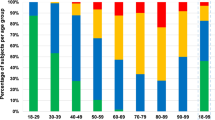Abstract
The lower cervical segments are commonly the level responsible for cervical spondylotic myelopathy; however, we rarely encounter stenosis at the upper cervical segment in a clinical setting. We assumed that there might be some differences between the pathogenetic mechanisms underlying the development of cervical canal stenosis at different segments. We performed positional MRI in the weight-bearing position for 295 consecutive symptomatic patients. All subjects were classified into four groups (A: normal; B: C3-4 stenosis; C: C5-6 stenosis; D: two-level cervical segments stenosis, stenosis at C3-4 and C5-6). Age, sagittal cervical canal diameter, cervical intervertebral disc degeneration, cervical cord compression, and cervical mobilities were evaluated for each group. Group B showed a narrow cervical spinal canal structure at the C3 to C4 pedicle levels, while groups C and D showed narrow structures at the C4 to C6 pedicle levels in the cervical spine. Additionally, the sagittal cervical canal diameters at all pedicle levels, except C7, in group D were significantly smaller than those observed in group C. We demonstrated the differences in the pathogenetic processes for the development of cervical spinal canal stenosis between C3-4, C5-6, and two-level cervical segments stenosis. Our results suggest that the developmental morphological structure of the cervical spinal canal plays an important role in the development of cervical canal stenosis at different segments. Moreover, individuals with sagittal cervical canal diameters of less than 13 mm may be exposed to an increased risk for future development of cervical spinal canal stenosis at the upper cervical segments following stenosis at the lower cervical segments.

Similar content being viewed by others
References
Edwards WC, LaRocca H (1983) The developmental segmental sagittal diameter of the cervical spinal canal in patients with cervical spondylosis. Spine 8:20–27
Gore DR (2001) Roentgenographic findings in the cervical spine in asymptomatic persons: a ten-year follow-up. Spine 26:2463–2466
Hayashi H, Okada K, Hamada M, Tada K, Ueno R (1987) Etiologic factors of myelopathy: a radiographic evaluation of the aging changes in the cervical spine. Clin Orthop 214:200–209
Torg JS, Naranja RJ Jr, Pavlov H, Galinat BJ, Warren R, Stine RA (1996) The relationship of developmental narrowing of the cervical spinal canal to reversible and irreversible injury of the cervical spinal cord in football players. J Bone Joint Surg [Am] 78:1308–1314
Bailey RW (1974) The cervical spine. Lippincott-Raven, Philadelphia, PA
Boijsen E (1954) The cervical spinal canal in intraspinal expansive process. Acta Radiol 42:101–115
Chen Y, Chen D, Wang X, Lu X, Guo Y, He Z, Tian H (2009) Anterior corpectomy and fusion for severe ossification of posterior longitudinal ligament in the cervical spine. Int Orthop 33:477–482
DePalma A, Rothman R (1970) The intervertebral disc. W. B. Saunders Co., Philadelphia, PA, pp 35–46
Friedenberg ZB, Miller WT (1963) Degenerative disc disease of the cervical spine: A comparative study of asymptomatic and symptomatic patients. J Bone Joint Surg [Am] 45:1171–1178
Heller JG (2002) Surgical treatment of degenerative cervical disc disease. Orthopaedic Knowledge Update, Spine 2. AAOS, 32, pp 299-309
Schmitt-Sody M, Kirchhoff C, Buhmann S, Metz P, Birkenmaier C, Troullier H et al (2008) Timing of cervical spine stabilization and outcome in patients with rheumatoid arthritis. Int Orthop 32:511–516
Herzog RJ, Weins JJ, Dillingham MF, Sontag MJ (1991) Normal cervical spine morphometry and cervical spine stenosis in asymptomatic professional football players. Spine 16:178–186
Okada Y, Ikata T, Yamada H, Sakamoto R, Katoh S (1993) Magnetic resonance imaging study on the results of surgery for cervical compression myelopathy. Spine 18:2024–2029
Payne E, Spillane J (1957) The cervical spine and anatomico-pathological study of 70 specimens with particular reference to the problem of cervical spondylosis. Brain 80:571–596
Morishita Y, Hida S, Miyazaki M, Hong SW, Zou J, Wei F et al (2008) The effect of the degenerative changes in the functional spinal unit on the kinematics of the cervical spine. Spine 33:E178–E182
Miyazaki M, Hong SW, Yoon SH, Zou J, Tow B, Alanay A et al (2008) Kinematic analysis of the relationship between the grade of disc degeneration and motion unit of the cervical spine. Spine 33:187–193
Mihara H, Ohnari K, Hachiya M, Kondo S, Yamada K (2000) Cervical myelopathy caused by C3-4 spondylosis in elderly patients. Spine 25:796–800
Conflict of interest
The authors declare that they have no conflict of interest.
Author information
Authors and Affiliations
Corresponding author
Rights and permissions
About this article
Cite this article
Morishita, Y., Naito, M. & Wang, J.C. Cervical spinal canal stenosis: the differences between stenosis at the lower cervical and multiple segment levels. International Orthopaedics (SICOT) 35, 1517–1522 (2011). https://doi.org/10.1007/s00264-010-1169-3
Received:
Revised:
Accepted:
Published:
Issue Date:
DOI: https://doi.org/10.1007/s00264-010-1169-3




